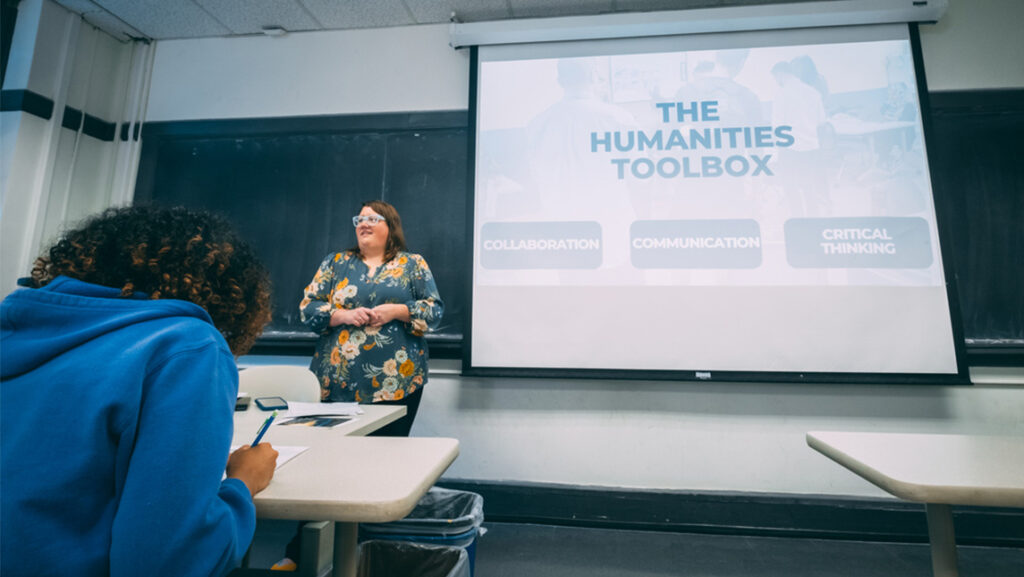Repost from UNCG NOW
As honey bees dance from flower to flower, they’re doing much more than making honey.
In fact, according to UNCG Biology Professor Dr. Olav Rueppell, the sticky, golden treat is just “a nice byproduct” of the honey bee’s most important task – pollinating plants and sustaining agriculture. Each year, however, up to 70 to 80 percent of a beekeeper’s honey bee populations can die off due to stresses caused by parasites, diseases, pesticides and nutrition issues.
Kaira Wagoner, UNCG’s Biology Department’s first doctoral student, has uncovered a chemical that could increase the odds of honey bee survival by helping them better combat the parasites within their hives.
Wagoner has been working in Rueppell’s lab under his mentorship since August 2011, when she began working on her Ph.D. in the newly established environmental health science program. She received bachelor’s degrees in biology and health science from Guilford College, and earned her master’s degree in biology from UNCG in 2011.
After studying the effects of malaria-carrying mosquitos in her master’s program, Wagoner said she wanted to study a “beneficial” insect for a change. She added that the “complex behaviors” of social insects such as honey bees added to their intrigue.
Wagoner’s research focuses on Varroa destructor, also called the Varroa mite.
The mite is “probably the single most problematic” issue for honey bees, she said. Not only is the mite a “physical burden to the honey bee,” it can also transmit viruses to the honey bee.
Varroa mites reproduce by infiltrating the special cells in a honey bee comb built for larvae. The mites lay their own young in the cell to feed off the baby honey bee. When that happens, the honey bee larvae give off a chemical signal that alerts the nurse honey bees to the presence of the mites and the disease that comes with it.
In response, the nurse bees uncap the wax covering from the cell to check for the mites, and if mites are present, they remove the larvae from the hive to prevent the spread of disease. That behavior is called “hygienic behavior,” Wagoner said.
Her research suggests that the chemical could be used as a tool to breed hygienic honey bee colonies that show increased hygienic behavior and are therefore more disease resistant hives.
Wagoner said she believes that if that specific chemical is sprayed over the top layer of all the honey bee cells in a hive, the nurse honey bees will uncap and check all the cells, increasing their chances of catching and emptying cells with the Varroa mites. Cells without mites will be recapped and the larvae left to develop normally.
“We think it will help reduce the parasite load of the colony,” Rueppell said.
And reducing the parasite load means reducing illness and death, leading to more honey bees to pollinate crops.
That’s not all Wagoner’s discovered about honey bees while working on her dissertation research, though.
When she began her research, Wagoner used plastic frames in her hives, but when she got tired of sawing plastic frames apart, she began using frames with a wax foundation instead. Those frames are stabilized by steel wires. After a while, Wagoner noticed something strange.
“There were lines of missing honey bee brood,” she said.
After further inspection, Wagoner realized that the empty brood cells were all located along the metal wires. So, she began testing younger brood that had not yet been removed, and found that they had six times more iron in them than those that weren’t located along the wire.
“As a result, we would recommend not using steel wire stabilizer,” she said.
Wagoner said she expects her findings, both about hygienic behavior and steel wires in frames to be published in the upcoming months. She passed her dissertation in mid-October and will continue to complete follow-up research through the end of the semester. She graduates in December, and is applying for post doctorate research and academic positions.
Story by Jeanie Groh, University Relations
Photography by Martin W. Kane, University Relations
Watch the awesome Time Warner Cable News coverage on Wagoner’s work: http://www.twcnews.com/nc/triad/news/2015/11/19/uncg-student-research-solve-global-beehive-mystery.html



